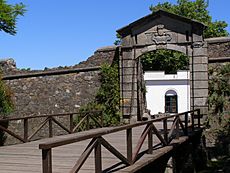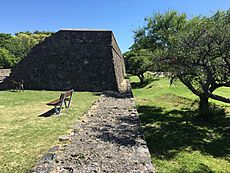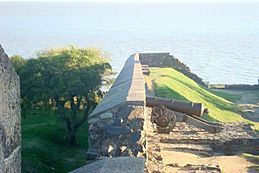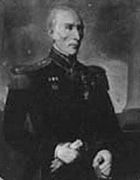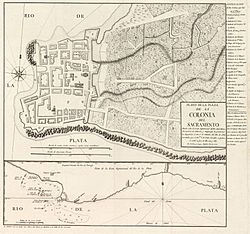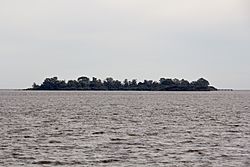Battle of Colonia del Sacramento (1826) facts for kids
Quick facts for kids Battle of Colonia del Sacramento |
|||||||
|---|---|---|---|---|---|---|---|
| Part of the Cisplatine War | |||||||
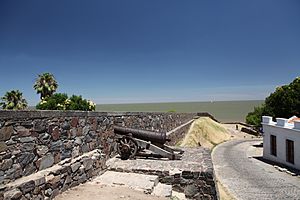 The old walls of Colonia del Sacramento |
|||||||
|
|||||||
| Belligerents | |||||||
| Commanders and leaders | |||||||
|
|||||||
| Strength | |||||||
|
Besieged forces: Unknown, at least 24 |
Besieging troops: +110 |
||||||
| Casualties and losses | |||||||
| 84: 32 killed 52 wounded 1 brig sunk |
200-500 killed, wounded and captured
1 brig sunk3 gunboats captured |
||||||
The Battle of Colonia del Sacramento was a series of attacks by Admiral William Brown of Argentina. He tried to capture the town of Colonia del Sacramento from Brazilian control. This happened during the Cisplatine War, a conflict between the Empire of Brazil and the United Provinces of the Río de la Plata (which later became Argentina). The fighting took place from February 26 to March 14, 1826.
Contents
Why Colonia del Sacramento Was Important
The town of Colonia del Sacramento had strong walls and was very important for the Brazilians. It was close to Buenos Aires, the capital of the United Provinces. The Brazilian navy was blocking the port of Buenos Aires. This meant ships could not easily enter or leave.
Colonia del Sacramento's port was a key spot for Brazilian ships. They used it to get supplies and continue their blockade. The town was protected by soldiers in a fort and cannons. Four small Brazilian ships also helped defend the port.
On February 22, 1826, Admiral William Brown learned about the Brazilian fleet. He decided to launch a surprise attack. Brown's fleet included a frigate, a barque, three brigs, and a schooner. His first plan was to attack the Brazilian fleet at night. However, the Brazilians noticed them and sailed away. Brown then decided to attack Colonia del Sacramento instead. The town was already being surrounded by land forces from Juan Antonio Lavalleja's army.
Before the Battle
Brown arrived at Colonia del Sacramento on the evening of February 25. He anchored his ships far from the town's cannons. He sent a message to the Brazilian commander, Brigadier Manuel Jorge Rodrigues, asking him to surrender.
| Commanders |
|---|
|
|
Brown's message said that if the Brazilians surrendered, the town and its people would be safe. He warned that if they did not, they would face a harsh attack.
Brigadier Rodrigues replied that only fighting would decide the town's fate. He refused to surrender.
The Brazilian commander of the ships, Frederico Mariath, held a meeting. They decided to anchor their four ships near the town's defenses. This would allow the ships to fire their cannons to help protect the town. They also moved eight ship cannons onto land. These cannons were placed in two spots to defend the port and prevent enemy landings. After receiving Rodrigues's reply, Admiral Brown ordered his men to begin the attack.
The Battle Begins
First Attack
On the morning of February 26, the Brazilians were ready for the attack. Their ships and land cannons were in position. The Argentine fleet approached from the southeast. They exchanged heavy cannon fire with the Brazilian defenses for over two hours.
During this fight, one of the Argentine ships, the brig Belgrano, ran aground. It got stuck dangerously close to the Brazilian cannons. The Brazilians focused their fire on it. Despite efforts to free the ship, its captain was killed, and many crew members were injured. The crew had to abandon the Belgrano.
That night, Admiral Brown signaled to stop the fighting. He sent another message to Rodrigues, again demanding surrender. Rodrigues's reply was short: "Tell the General in Chief, that what has been said has been said." This meant he still refused to surrender.
The fighting continued through the night. Admiral Brown realized his larger ships were too big to attack Colonia del Sacramento directly. He feared they would run aground like the Belgrano. So, he moved his ships away from the Brazilian cannons. He waited for six smaller gunboats to arrive as reinforcements. These gunboats were small enough for a landing attack.
That night, the Brazilians tried to burn the abandoned Belgrano. They worried it might float again with the high tide. They did not succeed, but they managed to send a schooner to Montevideo. This ship delivered news of the Argentine attack to the Brazilian admiral there.
| Order of battle | ||
|---|---|---|
| United Provinces | Empire of Brazil | |
|
|
|
Second Attack
On the night of March 1, 1826, Admiral Brown attacked Colonia del Sacramento again. This time, he planned to work with Juan Antonio Lavalleja's land forces. Brown hoped the land attack would distract the Brazilians, making it easier for his ships to land troops.
A few days earlier, Brown's fleet had received the six gunboats he asked for. Each gunboat had 30 men and one cannon. Brown's goal was to burn all the Brazilian ships except one, the Real Pedro, which he wanted to capture. About 200 of Brown's men were chosen for the landing. They were given special bottles to start fires.
At 10:30 PM, the six gunboats and two other boats quietly sailed towards the town. They split into two groups. However, at 11:45 PM, the Brazilians spotted them. They opened fire from their cannons on land and from their ships.
The Argentines tried to attack, but some gunboats were pushed close to the town's fort by the wind and current. They came under heavy fire from the Brazilian defenses. Many Argentine soldiers were injured. The Argentines managed to board the Brazilian brig Real Pedro and set it on fire. This lit up the night sky. However, they had to help their gunboats that were stuck near the port.
The land attack by Ramón Cáceres's forces did not happen. Cáceres was ready, but he received orders from Lavalleja not to attack.
Before dawn, the Argentines gave up the attack and pulled back. They left behind three gunboats, which the Brazilians captured. The Argentines suffered many casualties, with about 40 killed and 80 wounded. The Brazilians lost 19 killed and 10 wounded. Their ship, the Real Pedro, was burned and destroyed.
Final Actions
After the second attack, Brown ordered his ships to save ammunition. He hoped Lavalleja's troops would finally help. Brown ordered his ships to fire only a few shots during the day. At night, they practiced attacks on the port to keep the Brazilians on alert.
Lavalleja finally arrived on March 11. He met with Brown and apologized for not helping earlier. He told Brown he had 1,700 men and 12 cannons ready to attack. However, Brown was worried about Lavalleja's hesitation. Brown told him he had received orders on March 8 to stop the attack.
Aftermath
Admiral Rodrigo Ferreira Lobo, the Brazilian naval commander, was replaced by Rodrigo Pinto Guedes. Ferreira Lobo was replaced because he was seen as too passive and not active enough against the Argentines.
On March 14, Admiral Brown decided to leave Colonia del Sacramento. He feared the new Brazilian admiral would be more aggressive. Brown sailed back to Buenos Aires that same day. A large Brazilian fleet of 18 ships was waiting for Brown near an islet. However, Brown managed to sail past them and safely reached Buenos Aires.
See also
 In Spanish: Batalla de Colonia del Sacramento (1826) para niños
In Spanish: Batalla de Colonia del Sacramento (1826) para niños


